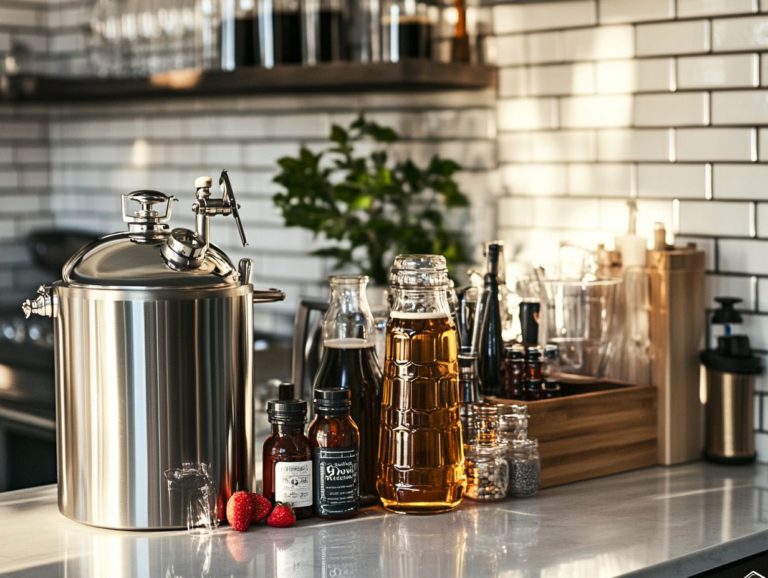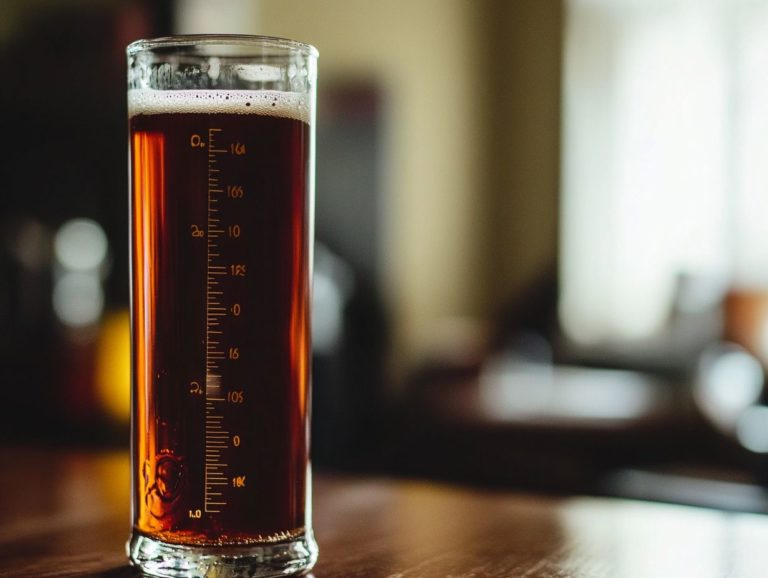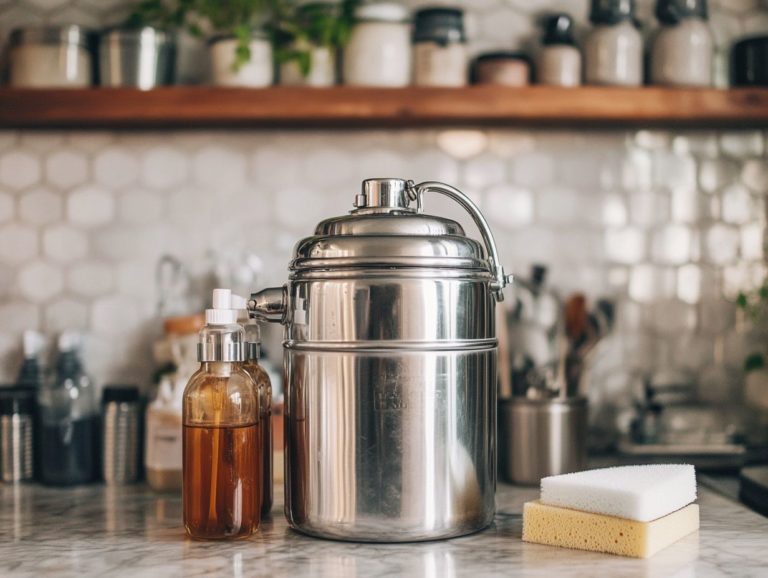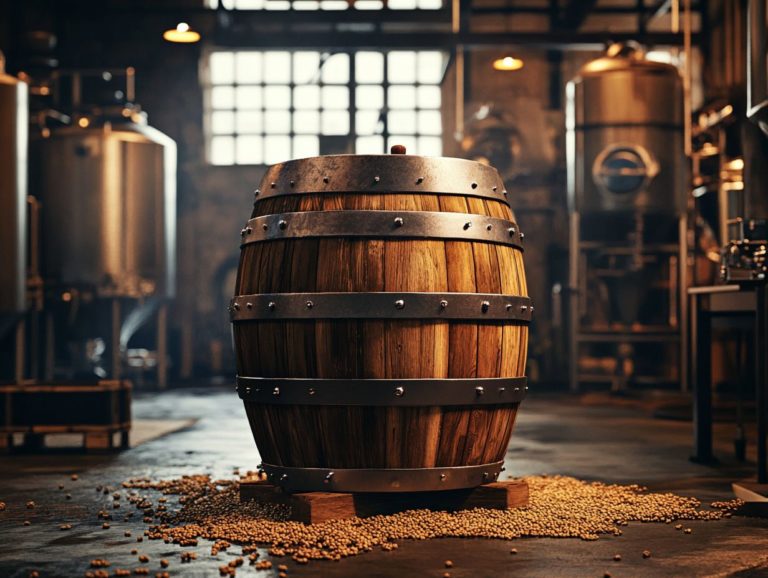Choosing the Perfect Kegging Equipment
Kegging equipment is an indispensable asset for both breweries and homebrewers, revolutionizing the way you store, carbonate, and serve your beer.
This guide delves into the various types of kegging equipment at your disposal, highlights the benefits of kegging compared to traditional bottling, and outlines essential factors to consider when choosing the perfect gear, including keg options and keg products.
Discover setup tips and maintenance insights for a flawless kegging experience. Let’s make your brewing journey both exciting and rewarding! Whether you re just starting out or you ve been brewing for years, this information will elevate your brewing journey to new heights, especially within the homebrewing community.
Contents
Key Takeaways:
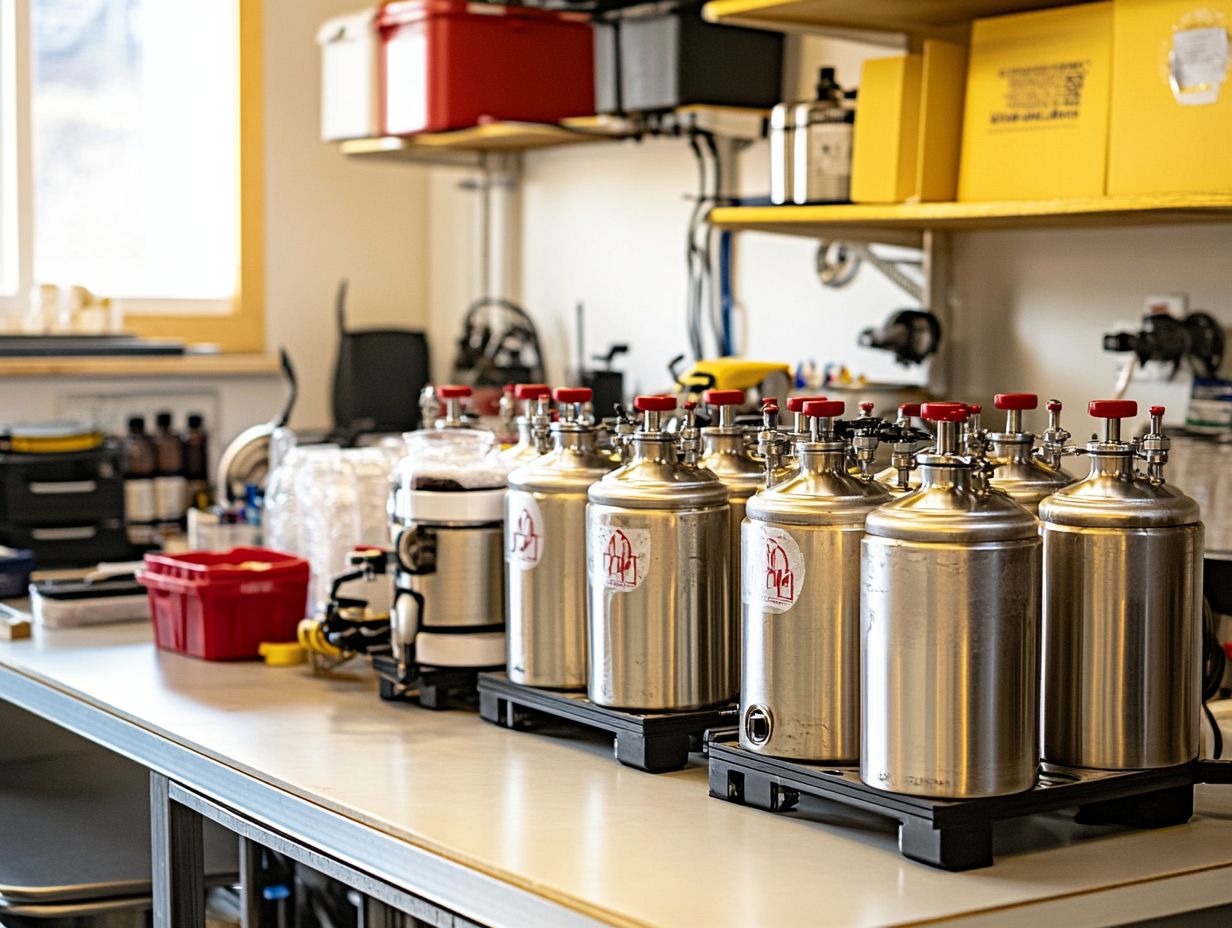
- Choose kegging equipment for easier and more efficient beer storage and serving.
- Consider factors like keg size, material, gas system compatibility, and cost when selecting kegging equipment.
- Proper cleaning and maintenance are essential for a successful kegging experience.
What is Kegging Equipment?
Kegging equipment is essential in your home brewing journey, providing a means to store, carbonate, and dispense your beers with remarkable efficiency. This specialized gear not only elevates the flavor and freshness of your brews but also streamlines the kegging process, making it a preferred choice within the homebrewing community.
Whether you re considering corny keg options or a complete kegging system, choosing the right equipment is crucial, whether you’re a novice or a seasoned brewer. With an array of keg types and products at your disposal, understanding the basics of kegging is the pivotal first step toward crafting that perfect pint.
What Are the Different Types of Kegging Equipment and Keg Components?
As you explore kegging equipment, it s essential to familiarize yourself with the various types available to brewers, such as Ball Lock and Pin Lock kegs, along with Kegerators for optimal beer storage and dispensing. Each keg type comes with its own set of unique features and benefits, catering to a range of brewing needs, including various kegging methods and keg components.
Take Ball Lock kegs, for example. They boast a straightforward and universally compatible connection design that many home brewers favor, thanks to their easy integration with common CO2 systems and gas disconnects. On the other hand, Pin Lock kegs, typically found in commercial settings, offer a more secure fitting, although they may lack the versatility that home brewers often seek.
Kegerators are another critical component of your brewing arsenal, designed to maintain your beer at the perfect temperature while enabling effortless dispensing. However, be prepared for a slightly higher price tag. Various accessories, including kegerator kits, faucets, beer faucets, and cleaning supplies, are vital for ensuring your beer s quality and hygiene remain top-notch.
By carefully weighing the pros and cons of each kegging option, you ll be equipped to make informed decisions that align perfectly with your specific brewing operation.
Why Choose Kegging Over Bottling?
Kegging offers exciting advantages over traditional bottling, especially in the home brewing arena where efficient carbonation and effortless dispensing are key. By embracing keg systems, you can achieve consistent keg pressure, minimize oxygen exposure, and simplify the beer storage process, making it a compelling option for many homebrewers. Weigh the potential downsides, including the initial setup costs and the maintenance that comes with the territory.
What Are the Benefits of Kegging Equipment?
Kegging equipment offers a wealth of benefits for you as a home brewer. It enhances your beer quality, improves storage capabilities, and provides unparalleled convenience for dispensing. With the right kegging tips and effective solutions, you can maintain the freshness of your favorite beverages while enjoying full control over every pour. Different kegging methods provide various benefits and trade-offs.
By utilizing kegging systems, you can achieve a higher level of carbonation accuracy. This greatly enhances the mouthfeel and overall flavor profile of your beer. Unlike bottling, where oxidation can easily become an issue, kegging reduces air exposure and preserves the unique characteristics of each brew. It also makes it easier to maintain consistent keg pressure.
Dispensing your beer becomes a breeze with a kegerator or tap system. This allows you to serve up quick refreshments at gatherings or during leisurely afternoons at home. This streamlined method not only saves you valuable time but also elevates your overall enjoyment of the brewing process. It makes for a more rewarding experience for both novice and seasoned brewers alike.
What to Consider When Choosing Kegging Equipment?
When choosing kegging equipment, several important factors come into play. Consider keg size, material and durability, gas system compatibility, and overall cost.
By grasping these key elements, you can make informed decisions tailored to your specific home brewing needs. This ensures that your kegging setup performs at its best.
Keg Size
Corny Keg Sizes
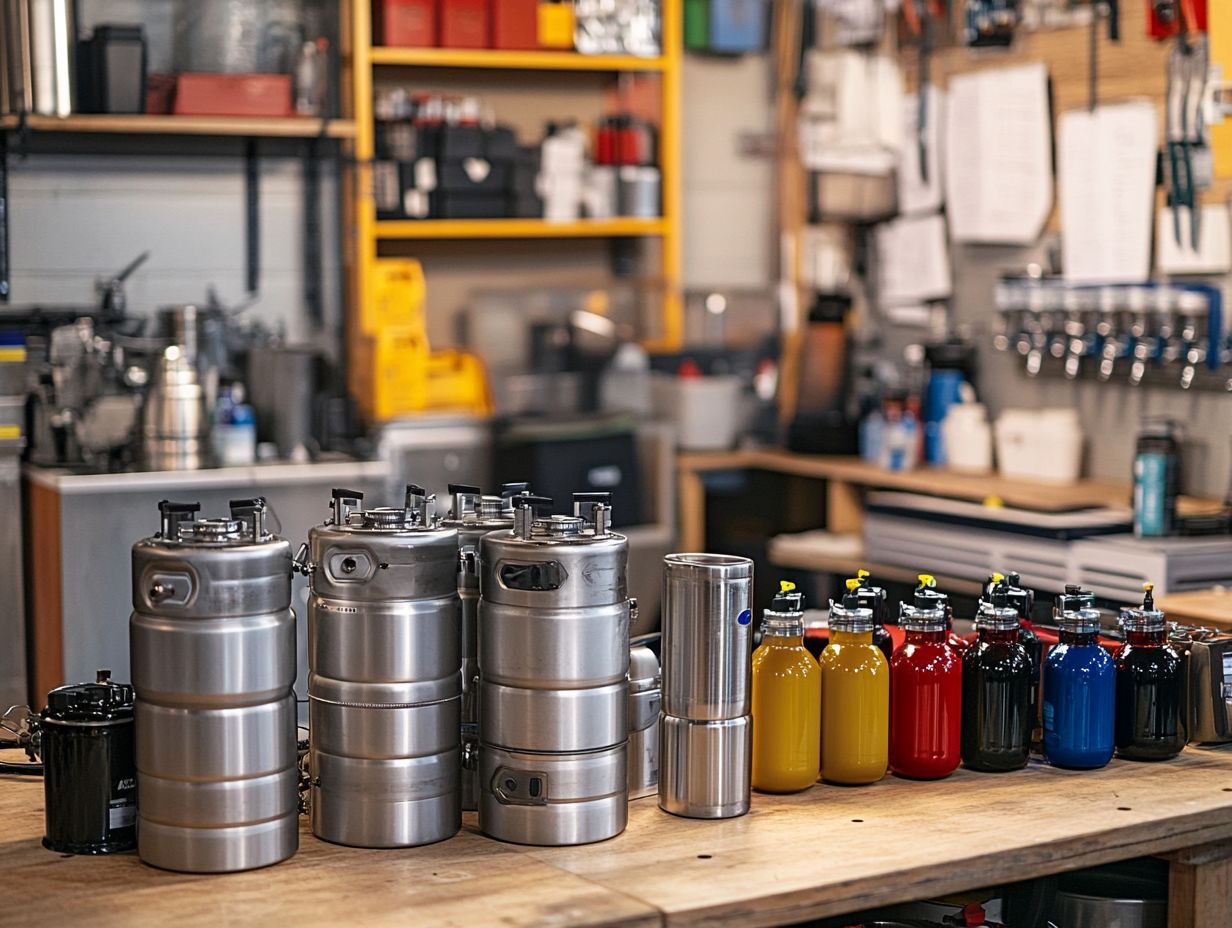
Selecting the right keg size is essential for your beer storage and dispensing needs. Options range from small corny kegs to larger capacities designed for various brewing setups. It’s important to consider the corny keg sizes that best fit your requirements.
Understanding how keg size relates to batch size is vital if you’re aiming to optimize your brewery’s operations. For instance, a typical 5-gallon corny keg is ideal for homebrewers producing smaller batches. It is perfect for testing new recipes or serving at gatherings. Conversely, a 15.5-gallon keg often called a full-size keg is suited for larger events or commercial environments where consumption rates soar. These corny keg sizes can be pivotal in determining your setup’s efficiency.
Choose the right keg size to supercharge your storage efficiency. It plays a critical role in carbonation levels and beer preservation. This decision ultimately influences the quality of the final product served to your customers. Corny kegs are a popular choice among homebrewers due to their versatility.
Material and Durability
When selecting kegging equipment, material and durability are crucial considerations. Stainless steel stands out as the preferred choice due to its remarkable resistance to corrosion and ease of cleaning. These features play a significant role in keg maintenance and longevity. Additionally, consider how these materials affect overall operational efficiency.
Alongside stainless steel, food-grade plastic frequently appears in keg construction. It provides a lightweight alternative for certain applications. While plastic kegs can be more economical and easier to transport, they often fall short in durability and protection against external elements when compared to their stainless steel counterparts.
This variance in material selection directly influences how well a keg can endure pressure, temperature fluctuations, and various stressors throughout the kegging process. Whether operating a small craft brewery or a large-scale production facility, careful consideration of these factors is essential. This ensures that your chosen kegs not only safeguard the quality of your beverages but also enhance operational efficiency and simplify maintenance.
Remember, proper keg maintenance is key to longevity.
3. Gas System Compatibility
Ensuring the compatibility of your gas system is paramount for achieving optimal kegging performance. The integration of components like a CO2 tank and pressure regulator directly affects the carbonation and dispensing of your beer. Make sure your gas supply and gas disconnects are compatible for seamless operation.
When every component is designed to work in perfect harmony, you gain precise control over carbonation levels. This control is essential for enhancing flavor profiles and ensuring freshness. The alignment of tubing materials, gas disconnects, and kegerators is crucial in preventing leaks and facilitating the efficient transfer of gas to the keg. Proper regulator settings are also vital to maintaining the correct pressure.
Choosing the right pressure settings influences how your beer flows and significantly impacts its overall quality and mouthfeel upon serving. Therefore, grasping the compatibility of these systems is vital for anyone who aspires to achieve the perfect pour every single time. Monitoring CO2 pressure carefully can make all the difference in beer dispensing.
4. Cost
Cost is a crucial factor to consider when evaluating kegging equipment, as the initial investment can vary widely based on your choice of kegs, keg products, and the complexity of your kegging setup. A well-thought-out kegging setup can save you money in the long run.
For example, the type of kegs you choose whether stainless steel or traditional plastic can have a significant impact on your overall expenses. Additional equipment like CO2 tanks, regulators, and tap handles will further add to the initial costs.
While it might be tempting to go for budget options, investing in high-quality kegging solutions pays off in the long run. Durable equipment ensures consistent performance and leads to long-term savings. By opting for quality, you minimize maintenance costs and elevate the overall drinking experience. This makes it a savvy financial move for anyone looking to maximize profitability and customer satisfaction.
Consider investing in a keg starter kit for an all-in-one solution.
Setting Up Your Kegging Equipment: A Step-by-Step Guide
Setting up kegging equipment demands meticulous attention to detail and adherence to specific steps. This process includes thoroughly cleaning the kegs, skillfully assembling the kegging system, and expertly connecting the gas and liquid lines. This ensures seamless operation.
Properly cleaning kegs and keeping an eye on the liquid connections are crucial for maintaining quality. By following the proper kegging setup protocols, you can guarantee that your equipment is primed for peak performance, allowing your home brew efforts to shine.
1. Cleaning and Sanitizing
Cleaning and sanitizing kegs is a crucial step in the kegging process. It ensures that your equipment is completely free from any contaminants and residues that could compromise the taste and quality of your beer. Utilizing effective cleaning solutions like PBW and Star San is highly recommended for this endeavor. Regularly cleaning kegs helps maintain the longevity of your kegging setup.
This practice is essential to keep your brew tasting its absolute best! It prevents any off-flavors that could emerge from improper sanitation. In the art of beer making, attention to detail is paramount, and adhering to best practices during the cleaning phase is essential.
By using high-quality products specifically designed for this task, such as those for cleaning kegs and beer line tubing, you can significantly reduce the risk of infection from wild yeast or bacteria. It’s vital to meticulously clean and rinse all components, including hoses, taps, and couplers, to eliminate any potential residues.
This includes maintaining beer faucets and keg storage areas. Implementing a routine cleaning schedule will help you consistently meet hygienic standards, ultimately leading to a superior final product that showcases your dedication to quality brewing.
2. Assembling the Kegging System
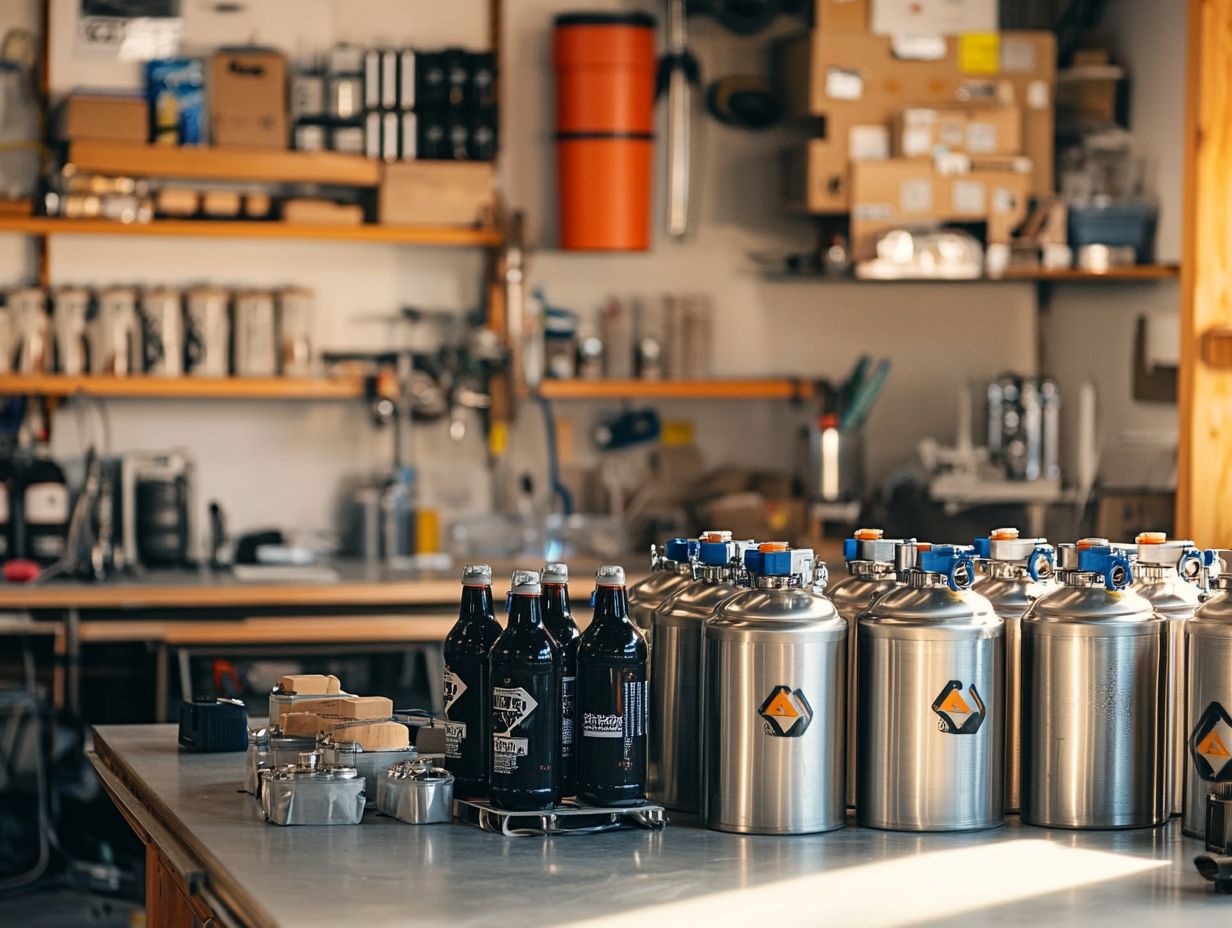
Assembling your kegging system requires careful attention to detail. Each keg component must fit perfectly for the best results in carbonating and dispensing your beer. Whether you are using a Cornelius Keg or another type, proper assembly is key.
Begin by gathering all the essential parts: the keg, CO2 tank, regulator, and connecting hoses. Understanding the purpose of each component is vital; for example, the CO2 tank delivers the pressure necessary to carbonate your beer, while the regulator controls the gas flow to maintain consistent performance. Utilizing John Guest Connectors can help ensure secure connections.
As you follow the instructions step by step, remember to check for any leaks after making connections, as even a small issue can impact overall efficiency. Prioritizing proper cleaning and sanitizing of all equipment before assembly is crucial. This will help ensure your beer retains its intended flavor and quality, allowing you to enjoy a seamless brewing experience.
3. Connecting the Gas and Liquid Lines
Connecting the gas and liquid lines is an essential step in your kegging setup. You’ll want to ensure that the gas disconnects and liquid disconnects are securely attached; this is crucial for maintaining the proper keg pressure and ensuring efficient beer dispensing.
This process isn t just about physically connecting the lines; it demands your careful attention to detail. A loose fitting can lead to leaks, negatively impacting the carbonation levels and overall flavor of your brew. Proper keg pressure is vital, as it dictates how smoothly the beer flows from the keg.
If your connection isn t up to par, you might end up dealing with excessive foam or, worse yet, flat pours. Kegging tips, such as using TMM Kegs or Intertap faucets, can aid in achieving better results. Establishing a tight seal on those connections protects against contamination, preserving the quality of the beer throughout its serving journey.
All these factors play a critical role, influencing not just the beer s taste but also the efficiency of your entire kegging setup.
How to Maintain and Troubleshoot Kegging Equipment?
Maintaining and troubleshooting your kegging equipment is crucial for achieving optimal performance and ensuring the quality of your beer over time. This involves not only routine keg maintenance but also employing proper cleaning techniques and addressing any common issues that may arise during use. Regularly checking your pressure relief valve is also crucial to ensure safety and performance.
By doing so, you can preserve the integrity of your brew and enhance the overall experience for yourself and your guests.
1. Regular Cleaning and Maintenance
Keep your kegging equipment clean and well-maintained for the best brewing experience! Regular cleaning and maintenance are essential to preserving the exceptional quality of your beer. It s wise to incorporate effective cleaning agents like PBW and reliable sanitizers such as Star San into your routine.
Proper keg maintenance can extend the life of your kegging system. Beyond these vital cleaning agents, you must ensure that every component hoses, taps, and kegs receives a thorough rinse after each use to prevent any residue buildup.
Consider establishing a routine where you disassemble and inspect your equipment periodically. This proactive approach can help you identify wear and tear before it escalates into larger problems. Utilizing a dedicated cleaning brush for taps and employing a proper soaking method for kegs will yield a deeper level of cleanliness. This is especially important for Cornelius Keg users who need to maintain their kegging equipment in top shape.
By engaging in these practices, you not only maintain the rich flavor of your brews but also extend the lifespan of your equipment, resulting in a more consistent and enjoyable brewing experience.
Don t wait start cleaning your kegging equipment today to ensure great-tasting beer for your next gathering!
2. Common Issues and How to Fix Them
Common issues with kegging equipment often arise from inconsistencies in keg pressure, gas supply problems, or improper connections. Addressing these challenges requires a step-by-step troubleshooting method that you can master. Regularly monitoring your CO2 pressure can help mitigate many of these issues.
You might often find yourself grappling with fluctuating keg pressure. This can lead to foamy pours or flat beer definitely not ideal for maintaining product quality and customer satisfaction.
It’s also possible for your gas supply to run low or become disconnected. This can compromise the overall flavor profile of your brew.
Improper connections can spell trouble too. They may lead to leaks or air ingress, which means unwanted air entering your beer and potentially spoiling its taste. Using kegging tips and regularly checking your beer line can help avoid these issues.
To effectively tackle these issues, start by regularly checking your pressure gauges and ensuring that gas lines are tightly connected. Utilizing a pressure regulator can help you maintain consistent pressure. Don t underestimate the value of periodic inspections of your entire kegging system to identify and resolve leaks early on. Adding a keg starter kit to your arsenal can also streamline the process.
By taking these proactive steps, you can ensure your brewing process runs like a well-oiled machine, keeping your customers thrilled!
Frequently Asked Questions
What should I consider when choosing the perfect kegging equipment?
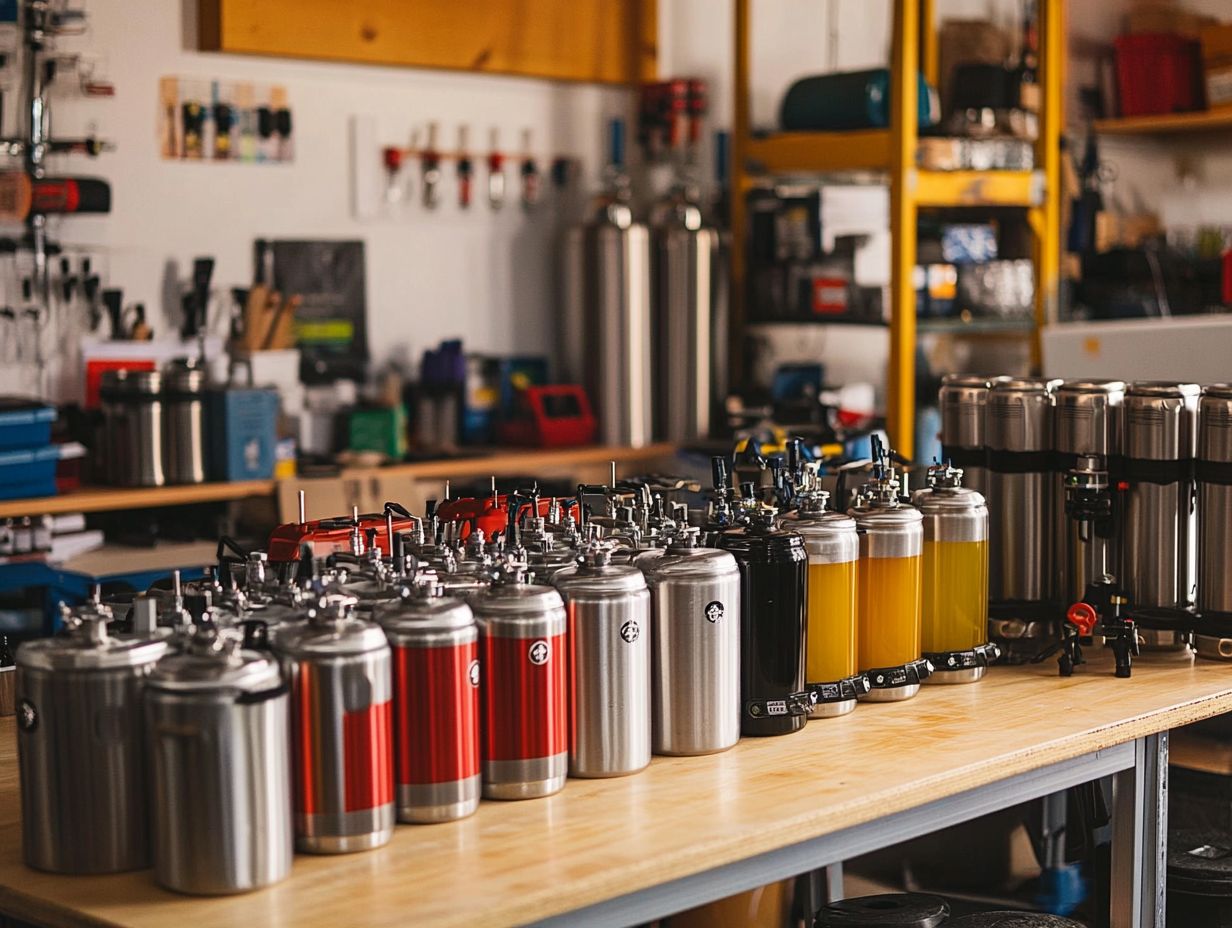
When choosing the perfect kegging equipment, consider factors such as your budget, the type of beer you will be kegging, the size and style of keg, and the number of taps you will need. Exploring different keg types and keg products can help you make an informed decision.
Can I use any type of keg for my homebrewed beer?
It is recommended to use a stainless steel keg specifically designed for homebrewing to ensure the best quality and taste of your beer. However, you can also use kegs from commercial breweries as long as they are properly cleaned and sanitized. Corny keg sizes can vary, so select one that fits your needs.
How many taps do I need for my kegging setup?
The number of taps you will need depends on how many different types of beer you plan to have on tap at once. Generally, one tap can serve one type of beer, so if you want multiple options, you will need multiple taps. Consider kegging solutions that offer flexibility in keg filling and dispensing.
What size of keg should I choose?
The most common sizes for kegs are 5 gallons and 15.5 gallons. 5-gallon kegs are more suitable for homebrewers or smaller gatherings, while 15.5-gallon kegs are better for commercial use or larger parties. The Danby Mini-Fridge can accommodate various keg sizes for convenient beer storage.
Can I use a CO2 tank with my kegging setup?
Yes, using a CO2 tank is necessary for pressurizing and dispensing your beer from the keg. Most kegging setups will come with a CO2 tank, or you can purchase one separately. Proper CO2 pressure is essential for maintaining the quality of your beer.
How do I clean and maintain my kegging equipment?
It is important to regularly clean and sanitize your kegging equipment to prevent contamination and maintain the quality of your beer. You can use a cleaning solution specifically made for kegs or a mixture of water and baking soda. It is also recommended to replace any worn or damaged parts to ensure optimal performance. Regular keg maintenance and following proper kegging methods can greatly enhance your brewing experience.

